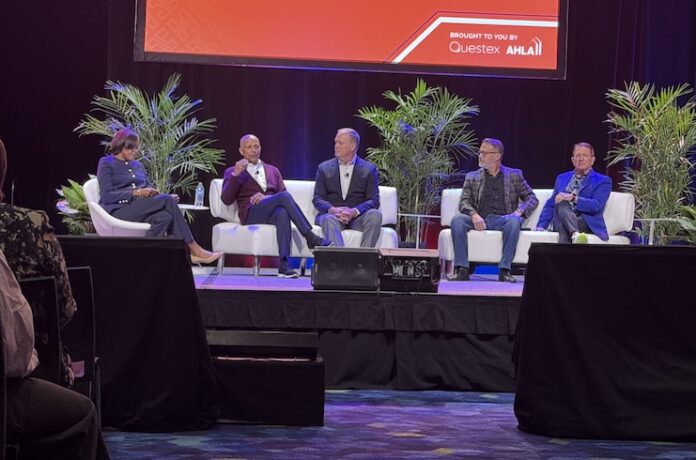
On day two of The Hospitality Show 2025, conversations centered on assessing the industry’s current landscape and exploring ways to navigate today’s constrained environment. Speakers emphasized the importance of building alignment to help address the difficulties created by a fragmented marketplace. Jeanelle Johnson, managing partner, PwC, led a panel titled “The Profit Engine: Aligning Ownership, Brand, and Operator” that, she said, explored “how profitability is driven not just by great brands or operational efficiency, but by alignment between owners, brand developers, and operational leaders, three groups with different incentives but shared outcomes.”
The panel leaders are seeing a variety of challenges in profitability. Navin Dimond, founder, Stonebridge Companies, said, “When we see a 1, 2, or 3 percent drop on the top line, it’s not the same on the bottom line. It’s going to be a multiple of maybe two or three times. So, while the top goes down to 2 or 3, your bottom line may go 6, 7, or 8 percent down. I think it’s really important to think about that early on from an owner’s perspective.”
Greg Lattin, regional vice president, Mid America and San Francisco Bay Area, Marriott International, noted how “this is a layered environment.” He emphasized, “You’ve got a lot of stuff happening very fast. You’ve got macro, very much a local scenario that affects profitability, and that combination, combined with the fact that we’ve got a lot of competition for customer preference…we still have demand issues in certain segments.”
“The reality is the fundamentals have changed,” shared Pete Sams, president, Highgate. “The dynamics have changed in our industry, and it’s a real struggle with eroding margins for owners.” He cited those fundamental changes stemming directly from the COVID-19 pandemic. “Having good dialog, understanding, getting aligned, and aligning goals and objectives is where we are today in the space.”
Jeff Wagoner, president and CEO, OUTRIGGER Hospitality Group, mentioned that the industry typically goes through cycles every 10 years or so, and each constituent is prepared for that cycle. “That’s happened a lot sooner this time around. … And now we’re posed with there’s some softening, and what’s happening out there, we’ve got international demand issues and some other things that we’re all wrestling with. …I think we’re in a very unique time that we haven’t gone through the traditional growth that we see in the industry over multiple years. We’re in a softening mode again, without the ability to find those places to create our profitability.”
To align the owner, brand, and operator, Lattin said that at Marriott, they have a history of “benefiting from the relationships we have with owners to affect the way we do things at the brand level and system-wide.” He added, “Thinking of it, teaching our folks and our leaders at all parts of the organization to think like an owner, to understand what is happening with each owner’s economics, and know how to bring to bear everything they possibly can to help is critical.”
Sams continued that “everyone has a vested interest in the outcome” of profitability. “I think in this circumstance, it’s really, to me, the paradigm shift. …I understand the dynamics of and we respect shareholder value and the big brands’ bottom line, but demonstrating that those two things don’t have to be mutually exclusive, that they can double down on…[and] make sure that the model is sustainable and profitable and heading in the right direction for our ownership community.”
“It seems like every time there’s a crisis, we sort of think of things to do,” Dimond added. “I think we’ve got to be a little bit more consistent and come up with changes that are there. They’re permanent changes, and mostly, probably a lot of this could be driven by the brands, and some of it may be just industry-related as well.”
Dimond also explained that, for the industry to “be agile, your mind and your team members need to be agile. The thing that’s constant in today’s world is change, and the rate of change is increasing. Things change faster, so the quicker you can adopt them, whatever it may be, learn to be agile. If you’re not, it’s going to be a struggle.”

